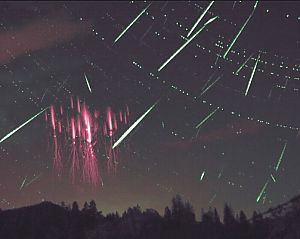Shooting star stream of the Perseids this year at night, but with competition

Always in mid-August, the Earth crosses the orbit of comet 109P/Swift-Tuttle, whose dust trail produces the shooting star rain of the Perseids. This happens because the dust grains collide with the Earth's atmosphere at about 60 kilometers per second. There they evaporate at high altitude, causing the air behind them to glow. The name "Perseids" comes from the fact that it looks like stars falling from the constellation of Perseus.
"Tears of Laurentius"
The meteor stream is also called "Tears of Laurentius" because its appearance coincides with the name day of the martyr Laurentius on August 10 and was interpreted as tears of the sky over his martyrdom. The constellation rises late in the evening in the northeast in mid-August and rises into the eastern half of the sky by dawn.
This year's young, waxing and therefore low-light moon sets in Vienna at 10:13 p.m., with the relatively pronounced darkness occurring shortly thereafter - in contrast to last year, when the maximum fell during daylight hours. The WAA speaks of "almost perfect conditions".
Up to 110 apparitions per hour
Theoretically, the shower promises up to 110 apparitions per hour. Conditions under which this is possible, however, are rare. "Even under ideal, dark conditions without moonlight or artificial light, only about 40 meteors per hour can be expected at first, starting at 9 p.m. This value slowly increases toward 105 at 5 a.m.," experts said. The rule of thumb is: the less disturbing light in the environment, the higher the chances. The farther away you are from city centers, the better.
In addition to light pollution from the ground, however, the Perseids also have increasing luminous competition in space: "Under the best conditions, we statistically expect nearly 60 Perseids between 10 p.m. and 11 p.m.. During this period, more than 360 Earth satellites - six times as many as meteors - will pass across the sky illuminated by the sun," says WAA President Alexander Pikhard. More than 80 percent of them belong to SpaceX's Starlink network.
Even though this year's conditions are particularly enticing, Pikhard urges people to seek out places that are not extremely frequented in order to maintain the Covid-recommended distances: "A shooting star shower is not such a spectacular celestial event that would be worth endangering one's own health or that of others." The association is foregoing a public viewing event again this year.
Translated with www.DeepL.com/Translator (free version)
